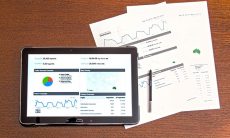Measurement is the key to a successful marketing strategy, but many marketers, small business owners, and marketing agencies fall flat when it comes to understanding how to use those numbers to determine real ROI. Fortunately, this is less of an issue than it was a few years ago. There are plenty of solutions and tips available to help you leverage analytics and data in a meaningful way. Here’s how you can use the data you already have to do more with your marketing.
Know What to Pay Attention To
It’s easy to get overwhelmed with customer data. After all, we’ve got website visits, customer actions, clickthroughs, signups, unsubscribes, and so much more to track. How can we actually make heads or tails of any of it?
Most of us can’t pay attention to all of it at the same time. But we can pick out the good stuff that really matters. What really matters to your brand? That might be the number of downloads a recent whitepaper has received, the number of clicks generated by a banner ad, or how many times people have tweeted your latest blog post. If you narrow down the data you’ve got to what really helps you make marketing decisions, you’ll have information you can actually use.
Use Digital Dashboards to Assess Data
Rather than logging into every account you need access to for this data, consider using a digital dashboard that houses all the measurable marketing data you need in a single location. For example, DataHero dashboards let you connect to your MailChimp, Salesforce, Eventbrite, HubSpot, and many other marketing tools so you can view and compare data across platforms.
Once you have a clear picture of your customers’ needs, wants, and habits, you can use that information to add some real oomph to your marketing efforts and even your social interaction.
Find out where your customers hang out the most and join them—on Twitter, Tumblr, Facebook–wherever they are, you are. After you start interacting on social media, you can evaluate your data to see how well you’re doing.
Get the Right People Involved
If the people who actually need to take steps to improve marketing don’t have access to the data you’ve collected, how can you expect anything to improve? Make sure both sales and marketing are involved and are regularly logging in to your dashboard to look at the data.
For example, marketing can evaluate the effectiveness of subject lines by looking at the data on email opens. The subject line is your enticement; it’s your marketing hook. By sending out different subject lines to small groups of subscribers and examining the results, marketing can find the most effective line and use that for bigger mailings.
Sales, in turn, can see what kind of offerings most appealed to buyers, and use that to add value to followup communications. Working hand-in-hand, marketing and sales can fine-tune marketing efforts for brilliant results.
Do Something With Your Data
Having these marketing measurements is just half your job. Now you have to determine what you’ll do with the information. For example, if the data tells you that your pay-per-click campaign isn’t doing as well as your email marketing, that’s a sign that you need to pull out of your PPC investment and focus more on email. You can use the data to find sticking points on your website that are keeping visitors from making a purchase. A few tweaks to the copy, and you may see an instant boost in conversion.
To make your data actionable, each item (responses, queries, email open statistics, etc.) should be owned by one of the people who have access to the information. Don’t leave it in the black ether for someone to pick up and do on their own volition. Assigning ownership encourages accountability.
Data is only good if you do something with it. Create a strategy for what you will measure, use the right tools to make your data easy to assess, and then make a game plan for changes designed to improve sales, traffic, and marketing.







